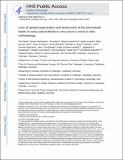| dc.contributor.author | Rothdiener, M. | |
| dc.contributor.author | Bast, S. | |
| dc.contributor.author | Uynuk-Ool, T. | |
| dc.contributor.author | Zouhair, S. | |
| dc.contributor.author | Ochs, B.G. | |
| dc.contributor.author | De Zwart, P. | |
| dc.contributor.author | Stoeckle, U. | |
| dc.contributor.author | Aicher, W.K. | |
| dc.contributor.author | Hart, M.L. | |
| dc.contributor.author | Shiozawa, T. | |
| dc.contributor.author | Schenke-Layland, K. | |
| dc.contributor.author | Venkatesan, J.K. | |
| dc.contributor.author | Cucchiarini, M. | |
| dc.contributor.author | Madry, H. | |
| dc.contributor.author | Kurz, B. | |
| dc.contributor.author | Felka, Tino | |
| dc.contributor.author | Grodzinsky, Alan J | |
| dc.contributor.author | Rolauffs, Bernd G | |
| dc.date.accessioned | 2018-09-17T13:36:44Z | |
| dc.date.available | 2018-09-17T13:36:44Z | |
| dc.date.issued | 2016-07 | |
| dc.identifier.issn | 10634584 | |
| dc.identifier.uri | http://hdl.handle.net/1721.1/117772 | |
| dc.description.abstract | Objectives: Current repair procedures for articular cartilage (AC) cannot restore the tissue's original form and function because neither changes in its architectural blueprint throughout life nor the respective biological understanding is fully available. We asked whether two unique elements of human cartilage architecture, the chondrocyte-surrounding pericellular matrix (PCM) and the superficial chondrocyte spatial organization (SCSO) beneath the articular surface (AS) are congenital, stable or dynamic throughout life. We hypothesized that inducing chondrocyte proliferation in vitro impairs organization and PCM and induces an advanced osteoarthritis (OA)-like structural phenotype of human cartilage. Methods: We recorded propidium-iodine-stained fetal and adult cartilage explants, arranged stages of organization into a sequence, and created a lifetime-summarizing SCSO model. To replicate the OA-associated dynamics revealed by our model, and to test our hypothesis, we transduced specifically early OA-explants with hFGF-2 for inducing proliferation. The PCM was examined using immuno- and auto-fluorescence, multiphoton second-harmonic-generation (SHG), and scanning electron microscopy (SEM). Results: Spatial organization evolved from fetal homogeneity, peaked with adult string-like arrangements, but was completely lost in OA. Loss of organization included PCM perforation (local micro-fibrillar collagen intensity decrease) and destruction [regional collagen type VI (CollVI) signal weakness or absence]. Importantly, both loss of organization and PCM destruction were successfully recapitulated in FGF-2-transduced explants. Conclusion: Induced proliferation of spatially characterized early OA-chondrocytes within standardized explants recapitulated the full range of loss of SCSO and PCM destruction, introducing a novel in vitro methodology. This methodology induces a structural phenotype of human cartilage that is similar to advanced OA and potentially of significance and utility. | en_US |
| dc.description.sponsorship | German Cancer Council (RO 2511/1-1) | en_US |
| dc.description.sponsorship | German Cancer Council ( RO 2511/2-1) | en_US |
| dc.description.sponsorship | German Cancer Council ( AI 16/23 TPI FIII) | en_US |
| dc.description.sponsorship | German Cancer Council (INST 2388/30-1 FUGG) | en_US |
| dc.description.sponsorship | National Institutes of Health (U.S.) (AR060331) | en_US |
| dc.publisher | Elsevier BV | en_US |
| dc.relation.isversionof | http://dx.doi.org/10.1016/J.JOCA.2016.02.001 | en_US |
| dc.rights | Creative Commons Attribution-Noncommercial-Share Alike | en_US |
| dc.rights.uri | http://creativecommons.org/licenses/by-nc-sa/4.0/ | en_US |
| dc.source | PMC | en_US |
| dc.title | Loss of spatial organization and destruction of the pericellular matrix in early osteoarthritis in vivo and in a novel in vitro methodology | en_US |
| dc.type | Article | en_US |
| dc.identifier.citation | Felka, T., M. Rothdiener, S. Bast, T. Uynuk-Ool, S. Zouhair, B.G. Ochs, P. De Zwart, et al. “Loss of Spatial Organization and Destruction of the Pericellular Matrix in Early Osteoarthritis in Vivo and in a Novel in Vitro Methodology.” Osteoarthritis and Cartilage 24, no. 7 (July 2016): 1200–1209. | en_US |
| dc.contributor.department | Harvard University--MIT Division of Health Sciences and Technology | en_US |
| dc.contributor.department | Massachusetts Institute of Technology. Center for Biomedical Engineering | en_US |
| dc.contributor.department | Massachusetts Institute of Technology. Department of Biological Engineering | en_US |
| dc.contributor.department | Massachusetts Institute of Technology. Department of Electrical Engineering and Computer Science | en_US |
| dc.contributor.department | Massachusetts Institute of Technology. Department of Mechanical Engineering | en_US |
| dc.contributor.mitauthor | Felka, Tino | |
| dc.contributor.mitauthor | Grodzinsky, Alan J | |
| dc.contributor.mitauthor | Rolauffs, Bernd G | |
| dc.relation.journal | Osteoarthritis and Cartilage | en_US |
| dc.eprint.version | Author's final manuscript | en_US |
| dc.type.uri | http://purl.org/eprint/type/JournalArticle | en_US |
| eprint.status | http://purl.org/eprint/status/PeerReviewed | en_US |
| dc.date.updated | 2018-09-06T16:29:52Z | |
| dspace.orderedauthors | Felka, T.; Rothdiener, M.; Bast, S.; Uynuk-Ool, T.; Zouhair, S.; Ochs, B.G.; De Zwart, P.; Stoeckle, U.; Aicher, W.K.; Hart, M.L.; Shiozawa, T.; Grodzinsky, A.J.; Schenke-Layland, K.; Venkatesan, J.K.; Cucchiarini, M.; Madry, H.; Kurz, B.; Rolauffs, B. | en_US |
| dspace.embargo.terms | N | en_US |
| dc.identifier.orcid | https://orcid.org/0000-0002-4942-3456 | |
| mit.license | OPEN_ACCESS_POLICY | en_US |
